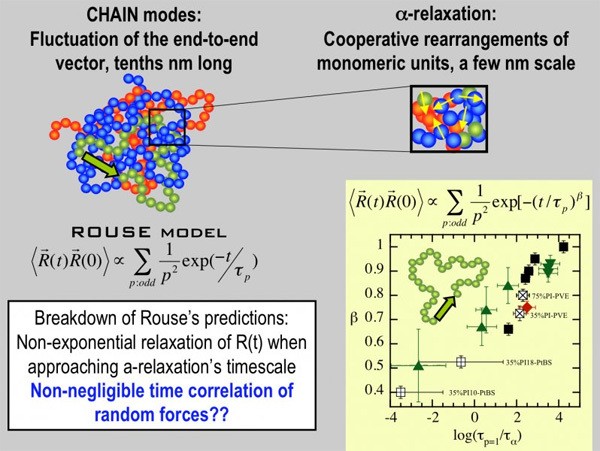POLYMER CHAIN DYNAMICS: EVIDENCE OF NONEXPONENTIAL MODE RELAXATION USING THERMALLY STIMULATED DEPOLARIZATION CURRENT TECHNIQUES
Fluctuations of the end-to-end vector of a polymer chain are at the basis of the viscoelastic properties having thus great impact on the preparation/processing and final application of macromolecular systems in general.

Although molecular dynamics simulations usually show deviations from the exponential behaviour, actual theories for macromolecular chain dynamics assume exponential relaxation for the different chain modes, i.e. the spatial and time correlations of the random forces acting on a polymer segment are neglected. Testing the question from an experimental point of view, however, is not straightforward as it is very difficult to record the response of a single mode, and generally a global response is measured and analyzed by assuming an addition of exponential modes.
In this work the authors have developed an experimental procedure to isolate the slowest chain mode (p=1) by means of thermally stimulated depolarization current (TSDC) technique. It has been shown that on approaching the range of the kinetic glass transition (Tg) the p=1 mode significantly deviates from an exponential decay, i.e., from the behaviour assumed by Rouse and tube-reptation theories. The effect is found to be more pronounced the closer the timescale of the p=1 chain mode and that of the local density fluctuations (a-relaxation) leading to the glass transition process. The observed behaviour is consistent with an scenario where exponentiality for the chain modes would be lost as a consequence of breaking the condition of time uncorrelation for the forces acting on a chain segment due to the slowing down of the local density fluctuations. Moreover, the phenomenology observed for homopolymers close to the glass transition resembles that observed for the chain dynamics of the fast component in blends with high dynamic asymmetry when approaching the glass transition of the slow component, and suggests a general interpretation for both contexts.



